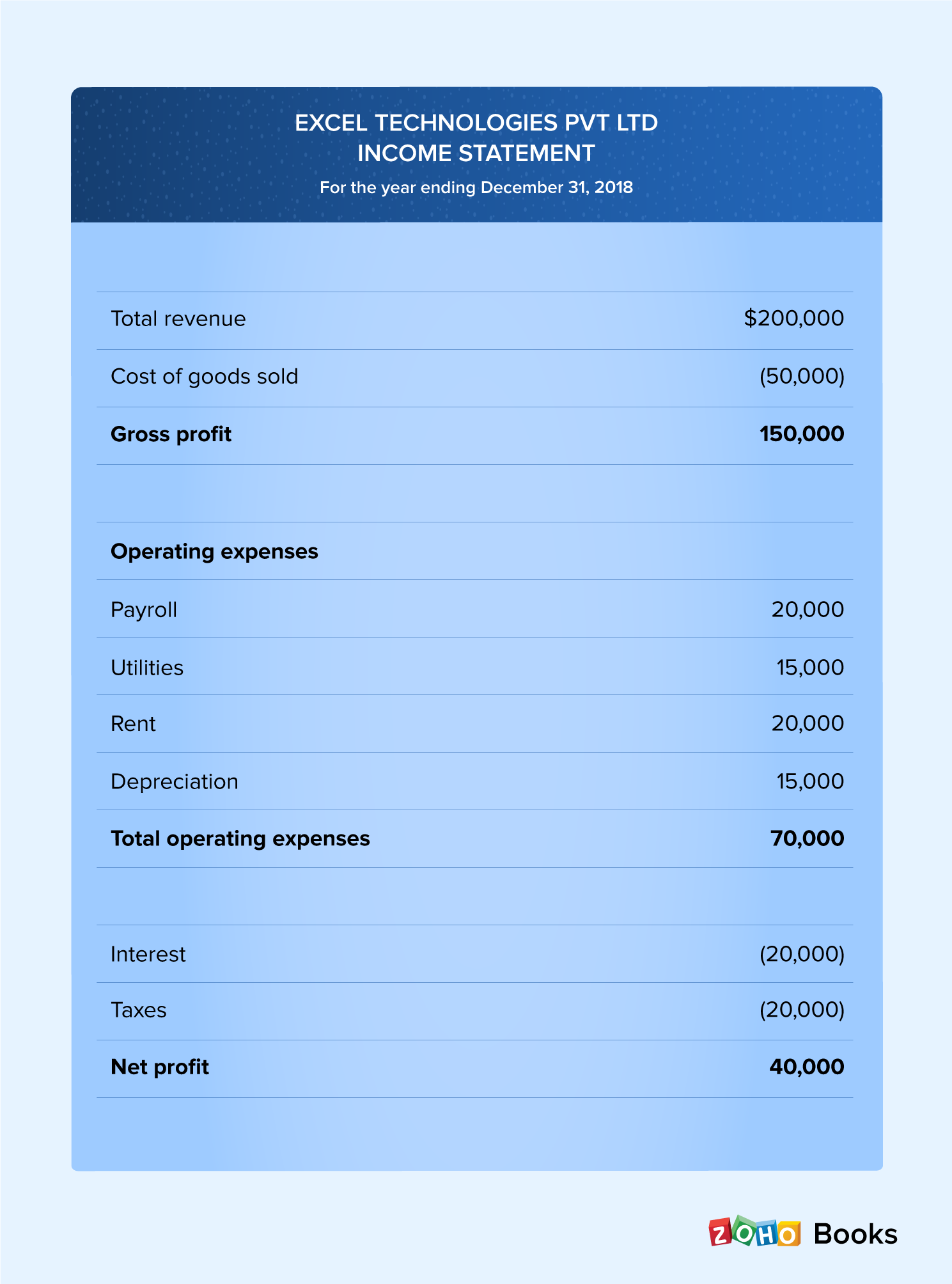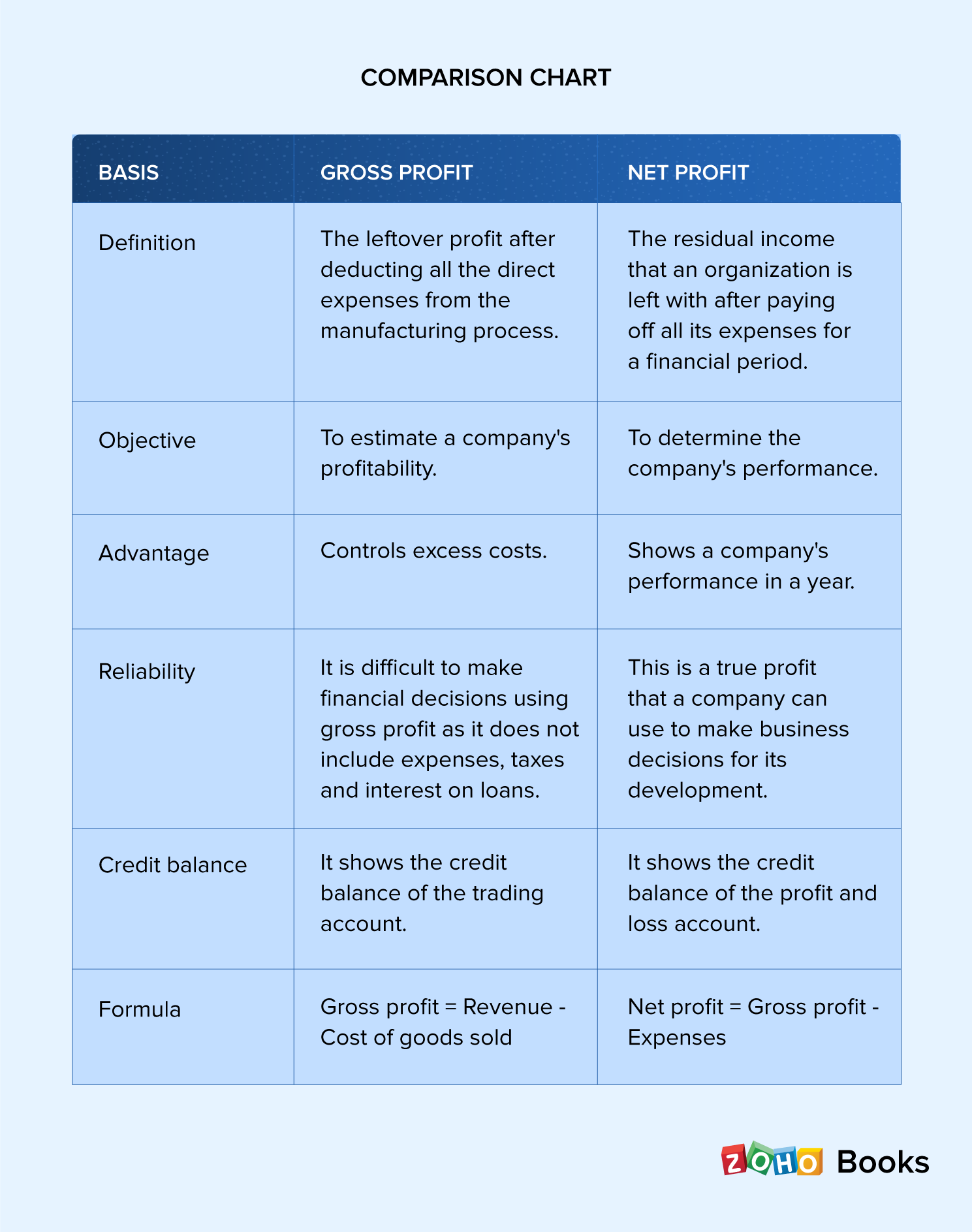- HOME
- Accounting Principles
- Gross Profit vs Net Profit – How are they different
Gross Profit vs Net Profit – How are they different

Profit is the money that a business brings in. Comparing current profits to profits from previous accounting periods helps you understand the growth of the business. To create accurate financial statements and monitor your business’s financial health, you should understand the two types of profits: gross profit and net profit.
What is gross profit?
Gross profit is the profit a business makes after subtracting all the costs that are related to manufacturing and selling its products or services. You can calculate gross profit by deducting the cost of goods sold (COGS) from your total sales.
While calculating the total sales, include all goods sold over a financial period, but exclude sales of fixed assets such as buildings or equipment.
What does gross profit tell you?
Gross profit is a measure of how efficiently an establishment uses labor and supplies for manufacturing goods or offering services to clients. It is an important figure when checking the profitability and financial performance of a business.
Gross profit helps you understand the costs needed to generate revenue. When the value of the cost of goods sold (COGS) increases, the gross profit value decreases, so you have less money to deal with your operating expenses. When the COGS value decreases, there will be an increase in profit, meaning you will have more money to spend for your business operations.
What is net profit?
Net profit is the amount of money your business earns after deducting all operating, interest, and tax expenses over a given period of time. To arrive at this value, you need to know a company’s gross profit. If the value of net profit is negative, then it is called net loss.
What does net profit tell you?
Net profit is another important parameter that determines the financial health of your business. It shows whether the business can make more than what it spends. You can use your net profit to help you decide when and how to work towards expanding your business and when to reduce your expenses.
For a business owner, it is important to know the difference between profit and profitability. Profit is an absolute number which is equal to revenue minus expenses. Profitability, on the other hand, is a relative number (a percentage) which is equal to the ratio between profit and revenue.
Profitability is a measure of efficiency and it is useful in determining the success or failure of a business.
Net profit tells you about the profitability of your business. Knowing about the same has several advantages beneficial for the business.
Most government forms and tax forms require you to declare your net profit. Based on your net profit, the financial institutions, like banks, decide whether to issue a loan or not. This stands true because net profit is a common field found on business tax forms. Furthermore, lenders and investors look at your company’s net profit to check if you own the capability to pay your future debts.
Importance of knowing the difference between gross profit and net profit
Net profit tells your creditors more about your business health and available cash than gross profit does. When investors want to invest in your company, they will refer to the net profit of your business to check whether it is worth investing their money.
Understanding gross profit trends, on the other hand, can help you find ways to minimize the cost of goods sold or raise your product prices. And if your gross profit is less than your net profit, then you know that you need to find a way to cut down your expenses.
You need to know the correct values of gross and net profit to generate an income statement: a financial statement that reflects the health of your business. Not knowing the difference between the two may result in inaccurate financial documents that present an unrealistic picture of your business. The three main financial documents aid the management in making important business decisions, so if they show incorrect profit information, it will affect their decision-making.
How to calculate gross and net profit?
You can calculate both gross and net profit using your income statement. An income statement shows your company’s total revenue and cost of goods sold, followed by the operating expenses, interest and taxes.
In the following example, we are looking at an annual income statement for Excel Technologies for the year 2018. The company records a total revenue of $200,000.

Gross profit = Total revenue – Cost of goods sold
= $200,000 – $50,000 = $150,000
Successful businesses show a positive value for gross profit. The money accounted as gross profit pays for expenses like overhead costs and income tax.
To calculate the net profit, you have to add up all the operating expenses first. Then you add the total operating expenses, including interest and taxes, and deduct it from the gross profit. In the above example, the total operating expenses including taxes and interest are $110,000.
Net profit = Gross profit – Expenses
= $150,000 – $110,000 = $40,000
When the value of net profit is positive, then the business owners can pay themselves and their partners after paying off their expenses.
When the value of net profit is negative, then it is called a net loss. This usually occurs in the case of new businesses that do not earn enough to pay off their overhead costs or income taxes. In such cases, keep track of each type of expenses so that you can find areas to cut down without sacrificing the company’s operations and efficiency. To avoid facing a net loss after tax payments, the company should track expenses by developing a budget that includes potential tax payments per year. This will help them develop sales goals that meet their financial needs.
Gross profit vs net profit – A comparison chart
Here’s a quick review of the differences between gross and net profit :

Your takeaway
Net profit reflects the amount of money you are left with after having paid all your allowable business expenses, while gross profit is the amount of money you are left with after deducting the cost of goods sold from revenue. You need to calculate gross profit to arrive at net profit. Once you know the correct values of your gross and net profit, you can generate an income statement. Gross profit and net profit are inter-dependent, so calculating the right values is important. This would keep the records maintained and help in determining if your business is performing efficiently.
Using Zoho Books, you can easily generate real-time business overview reports like P&L statements to evaluate the values of gross and net profit. Try out our cloud accounting software for free to know how it will help you generate and maintain your records while performing business activities efficiently.